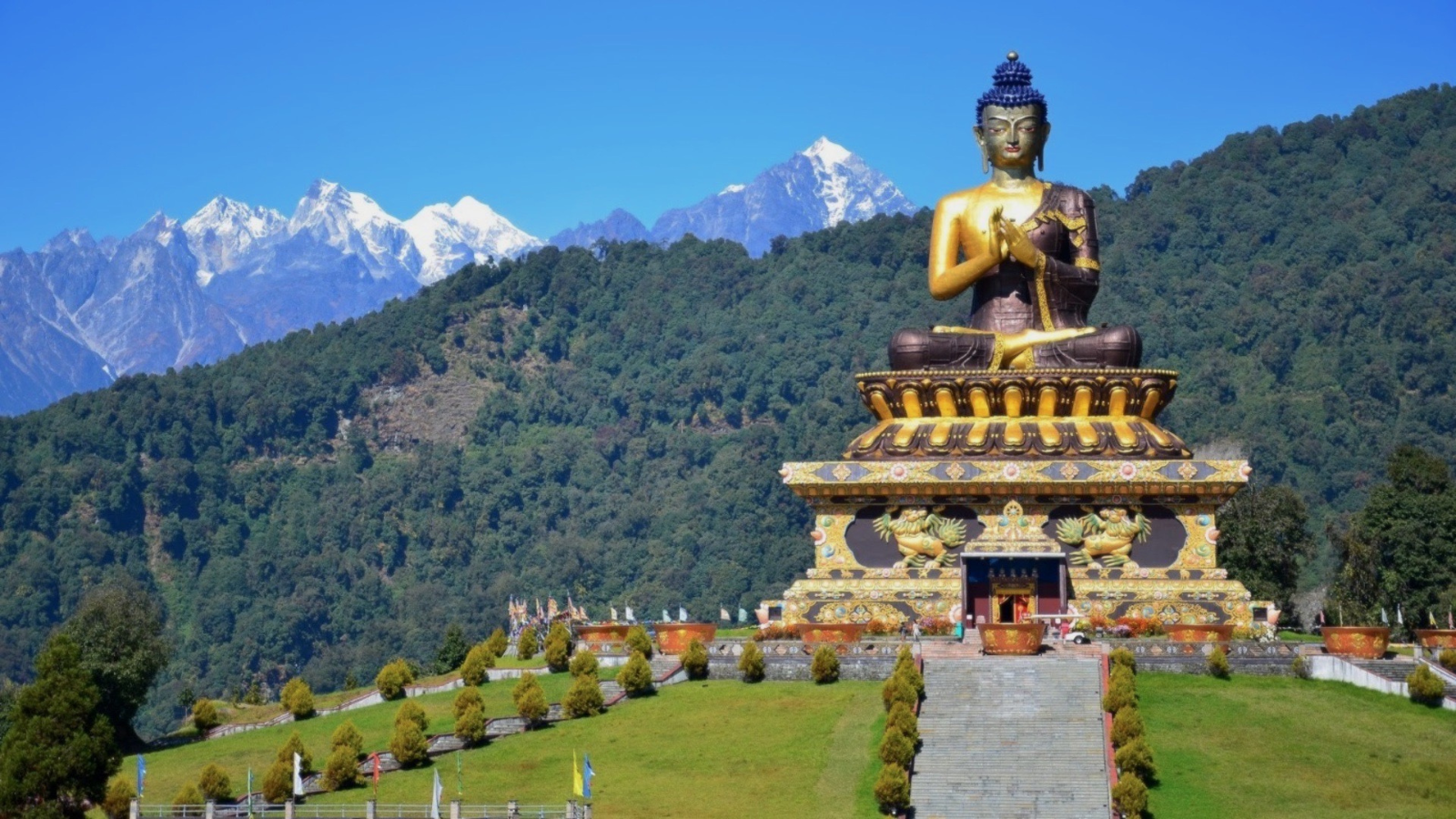The northeastern region of India, known for its stunning landscapes, rich cultural diversity, and vibrant traditions, is also home to some of the most serene and mystical Buddhist monasteries in the country. Nestled among lush green hills, these monasteries are not just places of worship but also repositories of ancient wisdom, art, and culture. The influence of Buddhism is deeply ingrained in the life and ethos of the local communities, making the monasteries significant pilgrimage sites for both spiritual seekers and tourists. This blog will take you on a journey through some of the most remarkable Buddhist monasteries in Northeast India, exploring their history, significance, and the tranquil beauty that surrounds them.
1. Tawang Monastery: The Crown Jewel of Arunachal Pradesh
Overview
Tawang Monastery, perched at an altitude of 3,300 meters in Arunachal Pradesh, is the largest Buddhist monastery in India and the second-largest in the world. Founded in the 17th century by Merak Lama Lodre Gyatso, the monastery is a major center of Tibetan Buddhism and a pivotal pilgrimage site for followers.
Historical Significance
Cultural Heritage: Tawang Monastery is not just an architectural marvel but also a vital cultural hub for the Monpa people, reflecting their rich heritage and traditions.
Religious Importance: It is home to around 450 monks and serves as a learning center for the Gelugpa school of Tibetan Buddhism, known for its emphasis on monastic discipline and scholarly pursuits.
Key Attractions
Main Prayer Hall (Dukhang): The main prayer hall houses a magnificent 18-foot statue of Buddha, surrounded by intricate murals and thangkas (Buddhist paintings).
Library and Museum: The monastery’s library contains ancient scriptures and texts, while the museum showcases artifacts, religious instruments, and traditional costumes.
Annual Festivals: The monastery celebrates various festivals with great fervor, including the Torgya Festival, which marks the end of the harvest season and features colorful dances and rituals.
Cultural Experience
Local Cuisine: Visitors can savor traditional Monpa cuisine, including thukpa (noodle soup) and momos (dumplings), at local eateries in Tawang.
Nature Trails: The stunning landscapes surrounding the monastery offer numerous trekking opportunities, allowing visitors to explore the beauty of Arunachal Pradesh.
2. Rumtek Monastery: The Seat of Tibetan Buddhism in Sikkim
Overview
Located about 24 kilometers from Gangtok, Rumtek Monastery is one of the most important monasteries of Tibetan Buddhism in India. Built in the 1960s by the 16th Karmapa, this monastery is a significant center for the Kagyu sect and serves as a hub for the preservation and practice of Tibetan Buddhism.
Historical Significance
Cultural Revival: Rumtek Monastery plays a vital role in the revival of Tibetan Buddhism after the 1959 Tibetan uprising, as many monks and practitioners sought refuge in India.
Pilgrimage Site: The monastery attracts thousands of pilgrims and tourists each year, making it a melting pot of culture and spirituality.
Key Attractions
Main Monastery: The main building features intricate woodwork, vibrant frescoes, and a stunning stupa containing relics of the 16th Karmapa.
Monastic University: The monastery is also home to a monastic university that imparts education in Buddhist philosophy and practices.
Beautiful Gardens: The well-maintained gardens surrounding the monastery provide a peaceful retreat for meditation and reflection.
Cultural Experience
Buddhist Rituals: Visitors can witness daily prayers and rituals performed by the resident monks, providing an insight into the spiritual practices of Tibetan Buddhism.
Local Markets: The nearby markets offer a chance to purchase handmade crafts, traditional Tibetan jewelry, and souvenirs.
3. Phugtal Monastery: A Hidden Gem in Zanskar
Overview
Phugtal Monastery, situated in the remote Zanskar Valley of Ladakh, is one of the most picturesque monasteries in India. Founded in the 12th century by the great Buddhist scholar and saint, Gangsem Sherap Sampo, the monastery is built into a cliff and resembles a honeycomb.
Historical Significance
Isolation: Due to its remote location, Phugtal Monastery has preserved its unique traditions and way of life, making it a valuable site for studying ancient Buddhist practices.
Cultural Significance: The monastery is an important center for the Gelugpa school of Tibetan Buddhism and is known for its serene atmosphere and contemplative environment.
Key Attractions
Architecture: The monastery’s unique architecture, carved into the rock face, is a marvel of engineering and artistry, offering breathtaking views of the surrounding mountains.
Cave Complex: The monastery has a cave complex where monks meditate and study, providing a glimpse into their ascetic lifestyle.
Stupas and Shrines: Phugtal is home to several stupas and shrines dedicated to various Buddhist deities, attracting pilgrims from across the region.
Cultural Experience
Trekking to Phugtal: The trek to Phugtal Monastery is a rewarding adventure, allowing visitors to experience the stunning landscapes and unique culture of the Zanskar Valley.
Local Community: Engage with the local community, known for their warmth and hospitality, and learn about their traditional lifestyles and customs.
4. Taktsang Monastery: The Tiger’s Nest of Bhutan
Overview
Though technically located in Bhutan, Taktsang Monastery, also known as the Tiger’s Nest, is often included in discussions about the monasteries of the Northeast due to its geographical and cultural proximity. Perched on a cliff at 3,120 meters above sea level, this iconic monastery is a sacred site for Buddhists and a major pilgrimage destination.
Historical Significance
Legends of Guru Padmasambhava: According to legend, Guru Padmasambhava, a prominent figure in Tibetan Buddhism, meditated in a cave here in the 8th century, making it a significant spiritual site.
Architectural Wonder: The monastery was built in the 17th century and is an architectural marvel, blending seamlessly into the cliffside.
Key Attractions
Stunning Views: The hike to the monastery offers breathtaking views of the Paro Valley and the surrounding mountains, making it a must-visit for nature lovers.
Main Shrine Room: Inside the monastery, visitors can explore various shrines, murals, and statues dedicated to Buddhist teachings.
Cultural Experience
Local Traditions: Experience the rich culture of Bhutan by participating in local festivals and rituals, which are deeply rooted in Buddhist traditions.
Crafts and Souvenirs: Explore local markets for handmade crafts, traditional clothing, and souvenirs to take home.
5. Bylakuppe Monastery: The Tibetan Settlement in Karnataka
Overview
Bylakuppe, located in Karnataka, is one of the largest Tibetan settlements in India and is home to several important monasteries, including the Namdroling Monastery (Golden Temple). Established in the 1960s, Bylakuppe has become a vibrant hub of Tibetan culture and Buddhism.
Historical Significance
Tibetan Refugee Settlement: After the 1959 Tibetan uprising, many Tibetans sought refuge in India, and Bylakuppe became a prominent settlement, preserving their culture and traditions.
Cultural Exchange: The settlement is known for its cultural exchanges, attracting visitors from all over India and beyond.
Key Attractions
Namdroling Monastery: The main monastery is famous for its stunning golden stupa and intricately decorated temples. The monastery is a center for the Nyingma school of Tibetan Buddhism.
Buddhist Teachings: The monastery offers teachings and workshops on Buddhist philosophy, attracting seekers from various backgrounds.
Cultural Experience
Festivals: Visitors can participate in vibrant festivals, including the annual Tibetan New Year (Losar), which features traditional dances, music, and rituals.
Tibetan Cuisine: Bylakuppe offers a chance to savor authentic Tibetan cuisine, including momos, thukpa, and butter tea.
Conclusion: A Journey of Spiritual Discovery
The Buddhist monasteries of Northeast India offer not only a glimpse into the rich heritage of Buddhism but also a unique opportunity for spiritual exploration and reflection. These sacred spaces, set against breathtaking natural backdrops, provide a serene environment for meditation, learning, and connecting with the teachings of the Buddha.
Whether you seek solace in the tranquil surroundings of Tawang, immerse yourself in the cultural richness of Rumtek, or embark on an adventure to Phugtal, each monastery promises a journey that transcends the ordinary. As you traverse the mystic trails of the northeast, you will not only discover the beauty of these ancient monasteries but also uncover the timeless wisdom and peace that they embody.









